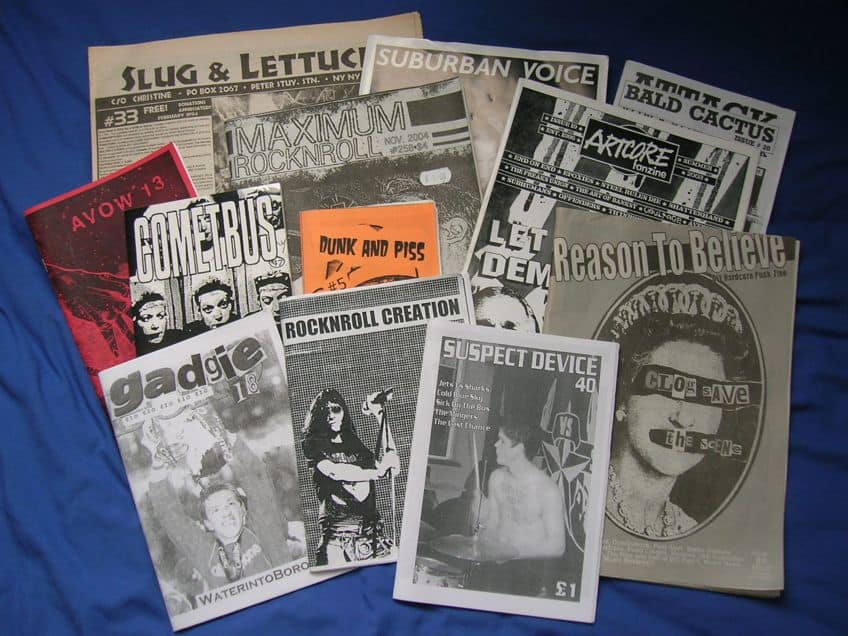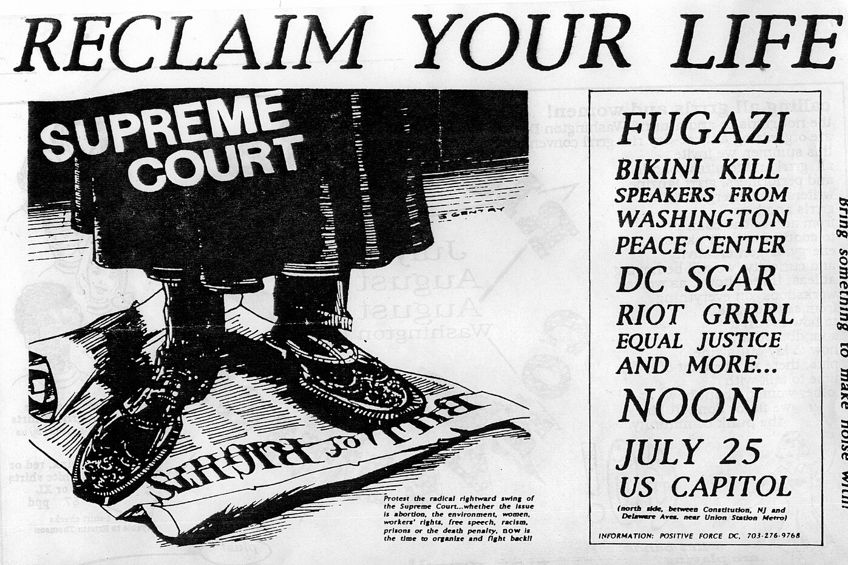What Is a Zine? – A Punk Revolution in Self-Publication
The 1980s birthed many anarchist media and artists, who from the context of the punk scene, disseminated information about artistic ideas, political pieces, and alternative underground music that fostered many communities of like-minded people. The creation of the fanzine was one such development of the punk scene that emerged as an anarchist tool for sharing ideas and concepts about almost any topic you could think of. In this article, we will examine the definition of a zine, including a few famous examples of zine art, and how these publications have helped shatter formal notions of information sharing within the 21st century. Read on to learn more about the art of zine-making and some of the talented zine artists out there!
An Introduction to Zine Art
Since the 1930s, publications called zines emerged as self-publicized and non-commercial mini booklets and pamphlets, that were produced usually by a small collective or individual. Zines can be produced in a multitude of ways and employ mostly your imagination and a piece of paper and glue. Over the decades artists have employed their creativity together with a photocopier or two, and a variety of cut-and-paste compositions to produce unique publications. So, what exactly is a zine, and how does one go about making one? Below, we will examine the history of zines, as well as their characteristics, a few famous examples of zines, their history and uses, and last but not least, a simple guide for beginners on how to create a zine.

What Is a Zine?
The term “zine” is pronounced as “zeen”, similar to how one would pronounce the word “magazine” in English. A zine refers to a self-published, small, or noncommercial booklet, which is created by an individual. These small publications can take the form of different sizes, formats, and shapes, and cover a variety of topics. Zines can be produced in a variety of ways using a photocopier or as printed offsets, such as newspapers or magazines.
The beauty of zine-making is that artists can choose how to visually compose and present information, which does not stick to a set guideline. As a result, many zines will often have a surprising and unique factor since they can range from random and sloppy cut-and-paste collage techniques to carefully handwritten and organized layouts. Texts and images can be appropriated from other print media and used to create new visual layouts and images to accompany handwritten or typed texts. Zines can also involve the use of other mediums like screen-printing, drawing, painting, calligraphy, and other media to enhance the visual impact and range in a zine. These small publications may also be hand-bound or mass-printed in a few hundred editions.
If one looks closely at the characteristics of zines, one will notice that they usually have a sense of a “DIY” approach that includes multiple topics, from politics to music, and not forgetting art.
These publications offer a great deal of range for artists to express themselves and engage in general and niche discourses that speak to their intended audience. Artists and other creatives can use zines to relay information, sharing their unique perspectives on the world while forming connections with those who share the same interests. A more formal definition of a zine follows the guide that its circulation must fall under an edition of 5,000 copies or less, while the majority of artists usually create under 1,000. Another major characteristic of zines in the traditional sense is that these publications are often not created for commercial purposes, although they may be sold as such by artists who choose to do so.

It is also key to recognize that zines are not expected to be as “perfectly composed” as that of publications like National Geographic or TIME magazines. As such, they may include incorrect grammar, radical ideas, opinions, criticism, and typos that make a zine feel more personal. The best part about zines is that there are no rigid guidelines for what zines should discuss or how they should be presented. Whether it contains personal essays, advice, movie reviews, comics, or political discussions, zines provide an idiosyncratic and personal approach to self-published books and the circulation of ideas and art.
The History of Zines
The conception of zines can be traced back to the early 20th century and amateur press movements of the late 19th century. Its history is strongly embedded in subcultures and countercultures, which emerged as a way for specific groups of people to share their interests and connect. Most notably, zines have also played a significant role in the traction behind punk and DIY movements through which people shared their ideas and disseminated information concerning political and social issues.
One should not underestimate the impact of zines in the history of art and the growth of subcultures and their reemergence in 21st-century society. Since the 20th century, zines have been used to publish opinions on issues that affected marginalized members of society, which acted as connecting points between Black literature during the Harlem Renaissance and various subcultures such as science fiction fandoms between the 1920s and 1930s.
Zines are also closely associated with a distinct graphic style, which was influenced by the subcultures and movements of Surrealism, Dada, Situationism, and Fluxus.
One can also time travel further into the past by looking at a pamphlet by Thomas Paine from 1775 titled Common Sense, Benjamin Franklin’s literary magazine for psychiatric patients at Pennsylvania Hospital. Other early examples include the 19th-century publication by Margaret Fuller and Ralph Emerson, titled The Dial. Most recently, in 2021, zines saw a revival in popular culture with the release of a film on Netflix titled Moxie, directed by Amy Poehler. The film drew connections to feminism and zine-making as a tool for advocating for women’s empowerment.

Due to the technological advancements of the 21st century, the demand for zines may have declined, however, its life in the digital age can still be found in the online space, as well as in print media. Zines remain a creative way for artists and professionals to share their experiences and ideas with the world. Whether you are creating a zine as part of a collective, art project, or independently for a public community, you can learn to appreciate the DIY ethos behind fanzines and engage more actively with hands-on processes that offer a personalized and accessible view of art.
Representing Marginalized Groups
In the 1920s, the use of zines was also seen in the Harlem Renaissance, where a group of African-American artists and literary creatives started to produce an independent publication dubbed “little magazine”, titled Fire!!. While only one issue of this publication was released, it sparked the publication of many other zines by various African-American writers and activists who took part in the movement. This zine movement is often overlooked, however, its impact, despite its small collective, was profound in establishing the history of zine-making and its use as a tool for representing marginalized societies. Zine culture was also rooted in the 1960s under the publications issued by the Black Panther Party, as well as in the 19th-century works of José Guadalupe Posada and the American Anti-Slavery Society.
Historical zines such as these are rare to come by and highlight not only the uniqueness and impact of zine culture but also the importance of preserving zines.
Famous Examples of Zines
Zines can be used to share information about almost anything, from highlighting societal ills to personal histories, poems, and visual artwork. Below, we will introduce you to a selection of famous zines that will hopefully inspire you to start incorporating zines into your practice. You may even consider replacing your lengthy newsletters with visually stimulating digital zines!

Flipside; Issue 6 (1978) by Los Angeles Flipside Fanzine
| Artist Name | Los Angeles Flipside Fanzine (1977 – 2002): Patrick DiPuccio, Steven Shoemaker, Sam Diaz, Al Kowalewski, Holly Duval Cornell, and others. |
| Date | 1978 |
| Medium | Printed zine |
| Dimensions (cm) | Unavailable |
| Where It Is Housed | Unavailable |
The Los Angeles Flipside Fanzine was a renowned 1970s punk zine that was founded by a group of students based in Whittier, California in 1977 and went on to establish its own record label called Flipside Records in 1978. The independent zine collective was credited with documenting the underground punk music scene and created many issues using photocopying and web offset printing methods, which later incorporated glossy covers.
The zines were first circulated in record stores around the Los Angeles area and grew in popularity within two years to reach 12 states and four countries.
The zine collective eventually started to mass-produce the zines using newsprint on a high-speed web press, which made the process more efficient. In the mid-1990s, the Los Angeles Flipside Fanzine also hosted their own events in the Mojave Desert at Jawbone Canyon, which debuted many local bands signed under their label. Through writing and zine publication, the key members of the group were able to not only promote the underground cultures of punk rock and new wave music and culture, but they also became part of the community.
Riot Grrrl (1991) by Members of Bikini Kill and Bratmobile
| Artist Name | Various members of Bikini Kill and Bratmobile, including Melissa Klein (n.d.) |
| Date | 1991 |
| Medium | Printed zine |
| Dimensions (cm) | Unavailable |
| Where It Is Housed | DC Public Library, The People’s Archive, DC Punk Archive, Melissa Klein Collection, Washington, D.C., United States |
Riot Grrrl was one of the most influential zine movements of the 1990s that was formed by a collective of young feminist artists operating from the punk and alternative music field. This collective addressed issues concerning gender inequality, sexual assault, and reproductive rights among women, and was best known for its confrontational style and appeal to raw and honest expression. The Riot Grrrl zine movement issued weekly printed zines that aimed to empower women through a close network that shared local events and information about feminist topics.
Between 1989 and 1996, the collective continued to publish works of diverse input from writers to performance artists and pieces about activism and art.
Their zines appealed to those who were interested in DIY culture, music, and print history, as well as gender and queer theory. Another famous example of their work was a bright neon pink poster that was printed with bold black text and advertised an event for young women in Portland in the 1990s. Since then, the zines of the Riot Grrrl movement have been acquired by various institutions and included material such as video recordings, notebooks, flyers, and artwork from the collective.

One Punk’s Guide to the Emergency Room; Tim Janchar (2023) by Razorcake
| Artist Name | Razorcake contributors: Tim Janchar, Art Fuentes, Emily Timm, and Todd Taylor (Est. 2001) |
| Date | 2023 |
| Medium | Digital zine |
| Dimensions (cm) | Unavailable |
| Where It Is Housed | Razorcake archive |
Razorcake is one of the most famous digital zine collectives in Los Angeles that releases bi-monthly fanzines about DIY punk culture and contemporary experiences that discuss a variety of topics informed by the lived experiences of its contributors. From illustrators to cartoonists and writers, the fanzine organization is a non-profit organization that was co-founded by a member of the former Flipside collective alongside Sean Carswell in 2001. The duo produced many webzines and printed zines that circulated across America. The collective acts as a unique resource to its community as it publishes videos, podcasts, articles, and comics that unpack as many aspects of its culture as possible.
The collective has since interviewed numerous bands and artists, from Career Suicide to Nate Powell.
Making a Zine: A Simple Guide for Beginners
Now that you have an idea of the different forms and topics that zines can encompass, you can feel free to create your own zine. To do this, you will need a sheet of paper, your choice of writing materials (this could be paint, pens, or Sharpies), and any other decorative medium that you wish to add later.
Below are a few simple steps to help you create your first zine.
- Place your sheet of paper in its horizontal position with the longest side of the page facing yourself. Once you start practicing more, you will find that this process will move much quicker!
- Fold the sheet of paper in half, dragging the top section down to the edge of the bottom section. Remember to press down on the fold to ensure your lines are solid.
- Unfold the paper and fold the sheet from the shorter ends in half. After this fold, you should be left with a cross-crease on the page.
- Next, you need to fold the outer sides (shorter ends) towards the mid-section of the page, as if you are closing pages of a book inwards.
- Unfold the page after pressing down on the creases and you should be left with eight equal rectangles. This is the basic format of your zine, which will create the pages.
- Finally, you will fold the entire page in half from one side of the page to the opposite side, such that the page is an A5 size.
- You will then use scissors to cut across the mid-section of the folded paper, only halfway across it, such that you create an opening in the center of the page.
- After you make the cut and unfold the sheet, face it horizontally in the same position you began, and fold the paper along the crease with the open slit.
- Hold the paper on either end and push the ends toward the middle, such that they fold into one another, and close to form an eight-page zine.
- Decorate your blank zine’s cover with images or texts that describe its contents or feel free to play around with whatever comes to mind first. Congratulations! You have just made your first zine!
The Influence of the Internet on Zines
Crucial to the development of zines and the establishment of various collectives was the emergence of fandoms, also recognized as subcultures of groups, that share a common passion for a person or character. With the rise of the Internet in the early 2000s, many zines were adapted into webzines, which gave rise to many E-zine artists. As a result of consciousness migrating to the Internet, the Do-It-Yourself culture had also expanded into other forms of engagement with zines and its distribution through blogging, social media, and blogging, which promoted a DIY publication model for aspiring zine makers.
Among the most significant early 2000s zines in the United Kingdom included Reason to Believe and Fracture, and Rancid News, the latter of which changed its name to Last Hours and maintained its lifespan on the Internet as a webzine to focus on anti-authoritarian cultures. Today, it is also crucial to consider the concept of anti-establishment culture, which seems to be the preferred choice for many independent artists, writers, and cultural workers. Alongside zines, other art forms such as comic illustration, poetry, and screen printing also thrived and were integrated with the theories and personal experiences of subcultures, which exposed art to a broader audience of people.

The role of the internet in shaping the evolution of the zine from its physical state to its digital form cannot be undermined. This shift outlines a similar pattern seen in our “need” to preserve texts, artworks, and unique collaborations in the digital space as the world shifts with an increasing reliance on technology. An excellent online resource where artists can explore more about zine-related topics and emerging zines is the usenet newsgroup known as alt. zines which was founded by Edward Vielmetti and Jerod Pore in 1992. The internet has also helped expand the culture of alternative publications well into the 21st century as seen in the emergence of zine libraries since the 2010s. This inspired many zine festivals and events around the world, which attract hundreds of exhibitors and artists, with the largest events occurring in the United States.
The world of zines offers much freedom to express oneself while relieving the pressure of producing perfectly worded publications. In embracing and preserving zine culture, we also get the opportunity to preserve histories and subcultures that are not as widely recognized as the visual trends and art genres seen in popular culture. A few other prominent zine collectives and zine artists include Punk Planet, Sniffin’ Glue, Aaron Elliott, Slash, and Buffalo Zine Ltd, among numerous contemporary zine groups.
The history of zine production and its role in recognizing and preserving underground cultures and marginalized societies makes the art form ever more so necessary in contemporary circles. Zines are a great way to bridge the connections between music, culture, history, art, literature, and many more creative practices that speak to broader audiences, while communicating relevant and nuanced information. Artists who lead zine-making intuitively and incorporate other forms of media into digital zine spaces encourage more engagement with wider audiences across the globe, which will hopefully inspire you to start thinking about how zines can assist you in spreading awareness about your art and issues that are important to you.
Frequently Asked Questions
What Is a Zine?
A zine refers to a self-published compilation of text and images, which may be appropriated from other sources and used to convey information. Zines are created as physical prints or published online as digital or webzines for circulation, and can discuss a variety of topics ranging from art to politics and music.
What Are Zines Used For?
Zines are used primarily to disseminate information relating to a particular topic or niche interest shared by a community or group. Zines serve a similar function to pamphlets or brochures and can be used for artistic or educational purposes.
Are Zines an Art Form or Type of Literature?
Zines emerged from the notion of the fanzine, which was initially an alternative and anarchist form of literature in punk subcultures. Over time, these publications included artworks and other types of contemporary media, leading to the development of an internal subculture. This subculture emerged as artists specializing in zine creation and who used the zine format and function to discuss and share art and ideas about art. The zine can be considered both an art form and a genre of literature.
Jordan Anthony is a film photographer, curator, and arts writer based in Cape Town, South Africa. Anthony schooled in Durban and graduated from the University of the Witwatersrand, Johannesburg, with a Bachelor of Art in Fine Arts. During her studies, she explored additional electives in archaeology and psychology, while focusing on themes such as healing, identity, dreams, and intuitive creation in her Contemporary art practice. She has since worked and collaborated with various professionals in the local art industry, including the KZNSA Gallery in Durban (with Strauss & Co.), Turbine Art Fair (via overheard in the gallery), and the Wits Art Museum.
Anthony’s interests include subjects and themes related to philosophy, memory, and esotericism. Her personal photography archive traces her exploration of film through abstract manipulations of color, portraiture, candid photography, and urban landscapes. Her favorite art movements include Surrealism and Fluxus, as well as art produced by ancient civilizations. Anthony’s earliest encounters with art began in childhood with a book on Salvador Dalí and imagery from old recipe books, medical books, and religious literature. She also enjoys the allure of found objects, brown noise, and constellations.
Learn more about Jordan Anthony and the Art in Context Team.
Cite this Article
Jordan, Anthony, “What Is a Zine? – A Punk Revolution in Self-Publication.” Art in Context. November 29, 2023. URL: https://artincontext.org/what-is-a-zine/
Anthony, J. (2023, 29 November). What Is a Zine? – A Punk Revolution in Self-Publication. Art in Context. https://artincontext.org/what-is-a-zine/
Anthony, Jordan. “What Is a Zine? – A Punk Revolution in Self-Publication.” Art in Context, November 29, 2023. https://artincontext.org/what-is-a-zine/.









